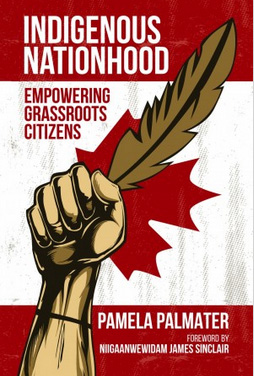Book Review: Indigenous Nationhood: Empowering grassroots citizens
 Reviewed by Shirley Honyust/ Yenatli:yo
Reviewed by Shirley Honyust/ Yenatli:yo
Pamela Palmater’s book, Indigenous Nationhood, inflames the passions of knowledge and that hunger as it addresses a number of issues that have marked the struggle for her own identity, politically and socially, as well as those of other First Nations citizens in Canada.
The potential reader only needs to take in a few words from the back cover to recognize that this is a must-read book for those who wish to increase their knowledge about the issues that impact on First Nations Peoples, both collectively and individually.
Her lineage is defined as a Mi’kmaq woman, though Palmater originally referred to her identity as a “Treaty Indian” and her status was not confirmed by her own people (Eel River Bar First Nation) until the passing of Bill C3. Prior to that legislation she, and others in her situation, were referred to as non-status Indians. The reason for this (In her own words) is “because there is a preference in the Indian Act for those who descend from the male line versus a female line.”
The author delves into landmark cases such as 5 year-old Jordan River Anderson from Norway House Cree First Nation, who was treated in hospital and not released to the care of his family because the federal and provincial governments couldn’t stop arguing over who would pay for his health care needs. He died in hospital in 2005, having never seen a day at home. Jordan’s Principle, to put the children first and fight about the money later, was passed through legislation in the House of Commons in 2007 and has yet to be implemented throughout Canada.
“Harper’s Indigenous Manifesto” gives a detailed chronology of steps taken by the federal government in their strategy to eliminate Indigenous identities. Read this chapter first to uncover what those policies were and why Palmater says they didn’t begin, nor will they end, with Harper’s term in office.
The chapter on “Idle No More” shares the growth of a movement by First Nations Peoples throughout Canada and beyond the borders. No one needed a resume, a CV, or specific knowledge, either indigenous or academic, to start or join a group within their locale. Palmater openly relates that she was honoured by the request of Idle No Move to be one of their organizers, educators and spokespersons. She defines the movement as a natural extension of the work already done by First Nations leaderships: traditional, elected and grassroots; and individual citizens who supported the movement in their own communities.
This is a book that resounds with clarity as Palmater tells the story. What First Nations Peoples’ wants and needs are: socially, educationally and politically and how they are being addressed (or not) in today’s political arena.
Disciplines of academia that would be enhanced from adding this book to their roster are: political science; law; media; corrections; sociology; history; environmental sciences and of course First Nations Studies. It would definitely lead to a more stimulating, motivated and informed post secondary educational experience.
Indigenous Nationhood by Pamela Palmater ISBN: 978-1-55266-795-8 (paperback), ISBN: 978-1-55266-796-5 (epub), Pages: 250. Published by: Fernwood Publishing, 32 Oceanvista Lane, Black Point, Nova Scotia B0J 1B0 and 748 Broadway Avenue, Winnipeg, Manitoba R3G 0X3


